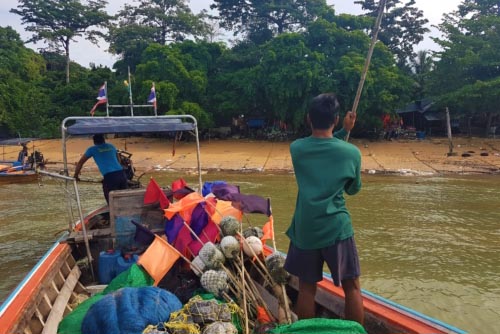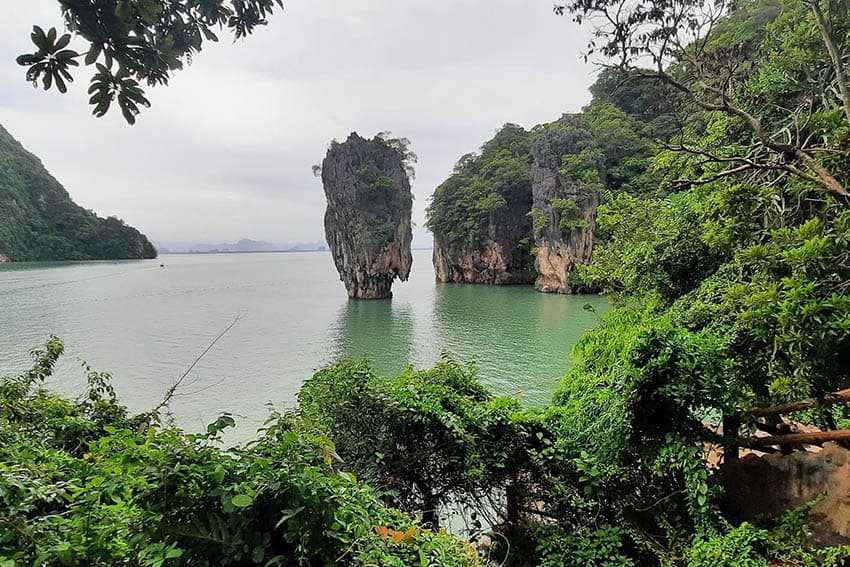Hangin’ with the Hill Tribes in Northern Thailand
By Terry Braverman
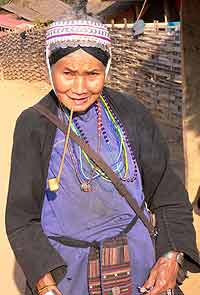
“Hello……hello….” The only English word most hill tribe people speak, it’s the initial greeting upon entering their villages, usually said to draw attention to the handcrafts for sale. The “I-sell-you-buy” association can be transcended in two ways. If you’re fluent in the universal languages of music, mime, and sound effects, it creates a connection beyond words.
Smiles, laughter, curiosity and engagement abound when I played harmonica, made faces, or imitated animal sounds in the village. Ultimately, a guide who has established relationships in the villages and is conversant in their languages will give you a PIN to access their world and withdraw cultural understanding, yielding a richer return on your experience.
New Year’s Party
If you’re a party animal, the best time to visit is January, when most tribes celebrate New Years. Rest assured no two parties are alike since each tribe has its own language, customs, costumes, cuisine, and spiritual beliefs. And you can never wear anything too outrageous at a hill tribe party. Their flamboyant attire makes rock stars look like bankers.
The term hill tribe refers to ethnic minorities residing in the mountainous regions of northern Thailand. Most of them migrated to Thailand within the last two hundred years from China (Hmong, Yao), Tibet (Akha, Lahu, Lisu), and Burma (Karen). All the tribes cultivate rice and corn; some grow other vegetables, fruit, and opium, while the Karens and Lisus raise livestock. Many of the communities have limited electricity and no indoor plumbing; homes are made of bamboo and thatched roofs.

The hill tribes face many challenges— poverty, drug abuse, prostitution and AIDS are common. Education is also problematic— there are few schools on tribal land. Despite their long-standing presence, the Thai government refuses to grant citizenship to hill tribes, fearing massive immigration from their brethren in bordering countries.
Hmong People
The Hmong people live high in the mountains near Chiang Mai, and it was astonishing to see so many pick-up trucks in the villages. But families are large and roads are virtually impassable, making pick-ups mandatory. Spiritual beliefs are animistic, and polygamy is common.
Women tend to put their hair up in a large bun, since they’re said to do the lion’s share of the work, lugging large baskets with broad shoulder straps and working the fields.
Hmongs have an unusual way of deciding where to construct a home. The household headman will burn money at the proposed site, and if nothing horrific happens for a week, they build.
The Hmong New Year festivity, known as “Noj Peb,” is drenched in colorful regalia and pageantry. An event that makes Chinese New Years look like a funeral, it’s not well-advertised to tourists. Over 2,000 Hmongs were in attendance, and I saw only three farangs (foreigners), including myself.
Activities ranged from wooden go-cart races to crossbow shooting, dance, and rituals. Some kids enrolled me in a variation of ball tossing that allowed me to showcase my sometimes slick, oftentimes clumsy moves which provoked laughter. Being among the Hmong was…well, a humongous pleasure.
Tha Ton
A three hour drive north of Chiang Mai is the picturesque town of Tha Ton, a gateway to more tribal territory. One morning I motorbiked with a local guide named Reinato to his Karen village in a lowland valley. Karens are renowned for their weaving skills, and dress in thickly woven v-necked tunics of various colors.
The missionaries came and conquered about 50 years ago—one settlement converted to Catholicism, another became Baptist, yet another went Buddhist. There were no Jewish converts in the area.
When Karens move, they carry ashes of their dead ancestors because they believe souls return to Earth. Marriage is mostly monogamous, and it’s easy to determine which women are available—single ladies wear white, married women either red or blue. Some enterprising Karen men have two wives—one red, the other blue.
We left Reinato’s home and plunged into a dense bamboo forest with some treacherous footing. The long steep trek and sheer beauty of the forest left us breathless, as we finally settled into a serene spot for lunch, Karen style.
My guide brought only food, and created all the utensils from bamboo branches. The rice servings were put into a banana leaf, then folded and stuffed into a hollow bamboo log with water, thrown into the fire and steamed. The chicken was put onto bamboo skewers, and the veggies inserted into a halved bamboo log. In an hour the food was cooked, and astoundingly delicious!
The Akhas
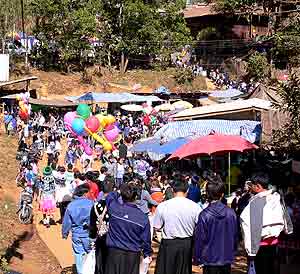
After lunch we visited the Akhas, who favor the high country. Their villages have a special entrance gate (two large posts with an overhead connecting post) to deter evil spirits. They practice animism with emphasis on ancestor worship. The homes have no windows, and the eaves drop quite low.
The Akha fashion statement favors black with very colorful trim, and ladies wear tall head dresses adorned with silver coins, beads, and feathers covering braided hair.
Sometimes their grins reveal red-stained teeth and gums, residue from chewing betel nut, a mild hallucinogen. The elderly Akha women are aggressive in their product sales approach—they attach their beaded bracelets to both your wrists, and hold out their hand for money. I should contract them to give sales training for U.S. department stores.
They were piling bracelets onto my wrists as I was attempting to play harmonica for their excited children, impeding my act in the process. Reinato just smiled and had that “everyone wants a piece of you” gleam in his eye.
The Lisu Settlement
The Lisu settlement was certainly the most “upscale” of all the tribes. They live in nicer homes and the road entering their community is paved. Socially liberal, premarital sex is reputedly common, along with free choice of marital partners, and divorce is permitted. However, people were very reticent, and the only tribe to decline photographing. Ancestor worship and spirit possession are part of their animistic beliefs.
Their clothes are lit with brilliant bold colors—women dress in long multicolored tunics over pants and sometimes black turbans with tassels; men sport baggy green or blue pants that are pegged in at the ankles. When we left Reinato elaborated on their prosperity, attributing it to drugs. Apparently, the tribal head of this Lisu village is a kingpin drug dealer who has been a periodic jailbird. It might just explain the taboo on photographs.
The final trek stop with Reinato was a Lahu community, where our timing was excellent—they were about to celebrate their New Year. The tribal chief allowed us to cook dinner, so we dined in a traditional Lahu hut on a bamboo strip floor, with a stone fireplace in the middle. Beeswax candles were lit to drive away evil spirits and honor their supreme deity, Geusha. As we ate, Lahu ladies were outside singing and chanting to the spirits, and the men were inside puffing opium cigarettes, hand-rolled from dried corn husks.
The men eventually nodded into oblivion, slumped on the floor. Divorce is common with Lahus…I wonder why. We finished eating and adjourned to an outdoor decorated space. Women toted their intricately woven yaam (shoulder bags), coveted by tribal crafts importers. Children were dancing in a circle around a platform, led by a musician playing a long necked instrument that sounded like a recorder. Other kids were exploding firecrackers, while the women sang beautifully and chanted well into the night.
Yao Village
In Chiang Rai province, I went to a Yao village. They’re animistic, highlighting ancestor worship and Taoism. Ladies wear black jackets with red fur-like collars, and trousers adorned with intricately embroidered patches. A village vendor offered plates of well-cooked beetles, crickets and bamboo larvae worms. Although the spicy aroma was tempting, I couldn’t get past the idea of ingesting bugs and worms.
I proceeded down the road to entertain the Yao kids, and an elderly man kept tugging at my arm as I was playing harmonica. He just wanted to play, but again it seemed disruptive. I reasoned inwardly that things like musical instruments were meant to be shared in his culture. If only I had an extra harmonica…
Despite some performance interruptus, it was ecstatically satisfying to connect with the hill tribes beyond language, living standards, ethnicity, and commerce. “Hello” may be the only English word they know, but rapport can be realized through desire, patience, and a show.
WHERE I STAYED
Mae Kok River Village, Tha Ton – A secluded property, situated on the banks of the Mae Kok river at a cul-de-sac street juicy with small town Thai flavor. The walk into town is a great opportunity to observe and interact with townspeople, and treasure the sweeping views beyond the river to the hills that buffer Myanmar. The resort maintains an organic farm on the property, hiring local kids to work on the farm while teaching them sustainable methods. Student groups come from around the world and offer service on the farm or in local schools, from reading stories to building new classrooms, in turn receiving academic credits.
Location: Tha Ton, Chiang Mai province Tel: (66) 5 345 9355,6
Web site: maekok-river-village-resort.com
The Riverhouse, Chiang Rai – Also at the edge of the Mae Kok river, the Riverhouse sits across from Chiang Rai city. It has the look of a modern hotel, but possesses some lovely, distinctly Thai features. There is an eye-popping sculpture in the lobby titled, “The Kinaree Cave,” a grotto carved into part of a teakwood trunk five meters high (about 17 feet).
The rendering depicts refuge for the mythical half-bird, half-human goddess “Kinnaree,” symbol of aestheticism and mythical beauty. Outside beyond the pool and landscaped gardens is a bamboo footbridge to a peaceful mini-island brimming with banana trees. Next to the hotel entrance is a large farm where they grow a variety of crops.
Location: 482 Moo 4, Tambon Rimkok, Amphur Muang, Chiang Rai Tel: 66 5 375 0829
Web site: riverhouse-chiangrai.com
OTHER POINTS OF INTEREST
THA TON – A bona fide slice of Thai life, the morning market is abuzz with locals transacting goods and services at 8 am. Located on “ Main Street.” Take a hike behind the road to the monastery for a free breakfast, then farther up to the Buddha with Seven Snakeheads at sunset. If you’re a performer, offer to entertain at the local elementary school.
CHIANG RAI CITY –
Hill Tribe Museum & Education Center : The 3rd floor of the facility serves as a museum with typical clothing for six major tribes, folk implements and other anthropological exhibits. Also offered is a 25 minute slide show on hill tribes. Admission to the show is 20 Baht. Open: 9 am – 8 pm daily.
Location: 620/1 Thanon Thanalai. Tel: 05 371 9167, or 05 371 1475
Oub Kham Museum: Royal garb from the 15 th century, and filled with ritual pieces, lacquer ware, and silver jewelry. Considered one of the finest museums in Asia. A visit here can consolidate your time exploring the lavish objets d’art and handcrafts of the local people. Admission: 100 Baht. Open 10am – 9pm daily.
Location: San Khong Noi Road near Den Ha market, 1 kilometer from the centre of town. Tel: 05 371 3349
Buddha caves: Follow the road across Mae Fah Luang bridge to the Tham To Pu turn-off, 800m from the bridge. Follow this road 1.2km to arrive at the caves on the side of a limestone cliff.
King Mengkrai monument and statue: Commemorates first Lanna king and founder of Chiang Rai.
Location: Intersection of Singhaklai Road, Uttarakit Road, and the Superhighway to Mae Chan.
Wat Phra Kaew: Originally the home of the Emerald Buddha but still has replica, surrounded by emerald stain glass. Location: Trairat Road, between Ruang Nakorn Road and Kraisorasit Road
Wat Phra Sing: A 14 th century temple, houses a replica of the Buddha’s footprint. Location: Singhaklai Road, between Overbrook Hospital and Tourist Police station
Night Market: Popular tourist spot for purchasing local crafts, and dining. Traditional dance performed nightly on large stage. Location: Next to the bus station.
CHIANG SAEN – ancient town on the Mekong River. Location: Take Highway 110 from Chiang Rai for 30 kilometers. Then take a right turn onto Highway 1016 and proceed for another 30 kilometers. Traces of old double city walls and other antiquities remain, both within and outside the town.
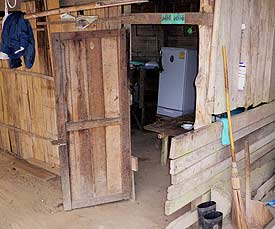
Wat Chedi Luang: Built in 1291. Largest pagoda in Chiang Rai province with 58 meter high brick wall surrounded by ruins.
National Museum: Provides information and exhibits on archeological sites and artifacts, town history, ethnic minorities along the Mekong River, and Buddha images. Open Wednesdays-Sundays, 9-4.
GOLDEN TRIANGLE – Viewpoint of where Thailand, Laos, and Myanmar converge. A tourist trap, but I highly recommend a visit to the Opium Museum in the village of Sop Ruak. Fascinating look at how opium is cultivated, and tools used for planting, harvesting and smoking the drug, along with weighing scales. Also, old photographs and maps of the poppy plantations.
MAE SAI – a border town situated on the River Sai opposite the Burmese berg of Tachilek, which you can visit for the day. It’s a bustling marketplace with a wide range of Burmese and Thai jewelry, handicrafts and other goods.
Tam Plaa ( Fish Cave): About eight kilometers south of Mai Sai, known for its interesting rock formations. Also, home to an extended family of monkeys.
DOI TUNG – First shrine in the Lanna Kingdom, revered by Thai, Lao, and Burmese Buddhists.
Location: Take Highway 110 for about 48 kilometers. Then turn left onto Highway No. 1149, an asphalt road leading to Doi Tung. The route winds through striking scenery with many interesting sites. These include Doi Tung Royal Villa, Mae Fa Luang Garden, Akha and Lahu tribal villages.
MAE SALONG – at an altitude of over 1200 meters, its mountain peak setting not only gives fantastic views, but can be quite mystical when the mists surround it. It was originally populated with a Nationalist Chinese army regiment that fled after communism took control in the 1949 revolution. Mae Salong will charm you with its plethora of Chinese tea houses and tea plantations. Location: Highway 1089 about 60 kilometers from Chiang Rai city.
HILL TRIBE DEVELOPMENT & WELFARE CENTER – aids and administers hill tribe settlements. Handcrafts, particularly woven cloth and silverware, are available for purchase. Location: 15 kilometers along the route to Mae Salong.
PHU CHEE F AH – This mountain top is the ultimate place to be at sunrise, with spectacular views of Laos and the Mekong River. About 60 kilometers east of Chiang Rai city.
ARK – A forested park about 65 kilometers south of Chiang Rai city, it covers 1,170 sq. kilometers, extending into areas of Chaing Mai, Lampang and Phayao provinces. Phu Kaeng waterfall is a major attraction.
 Terry Braverman travels internationally as a professional speaker, seminar leader and writer. His primary topic is based on his bestselling book, When the Going Gets Tough, the Tough Lighten Up!
Terry Braverman travels internationally as a professional speaker, seminar leader and writer. His primary topic is based on his bestselling book, When the Going Gets Tough, the Tough Lighten Up!
Read more stories by Terry Braverman:
Costa Rica: History, Geology and Pageantry
Chiang Mai Thailand: Change in the Air
Vientiane and Vicinity: Savoring Papaya, Pone and French Colonial Charm
- Mother’s Day Ideas - May 6, 2024
- Exploring Kenya’s Night Markets - May 3, 2024
- Exploring the Lesser-known Gems of France: - May 2, 2024


